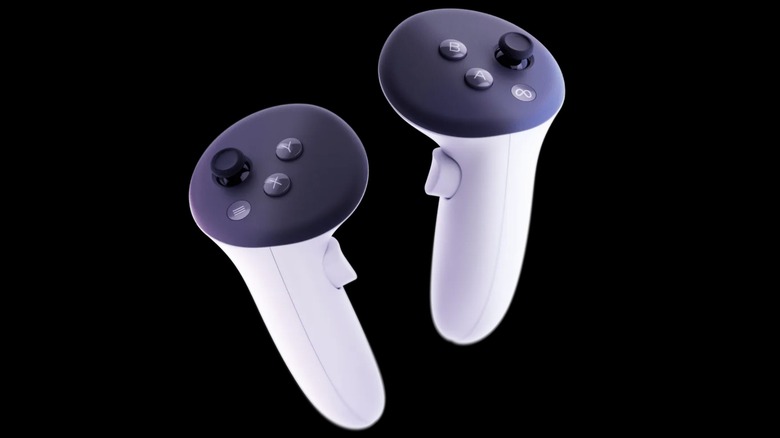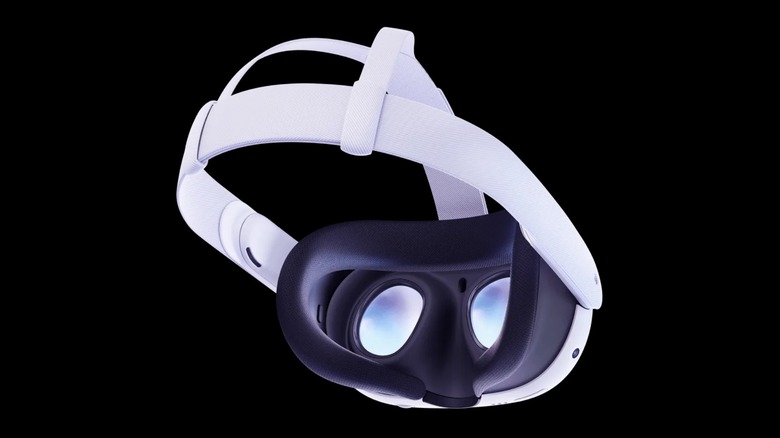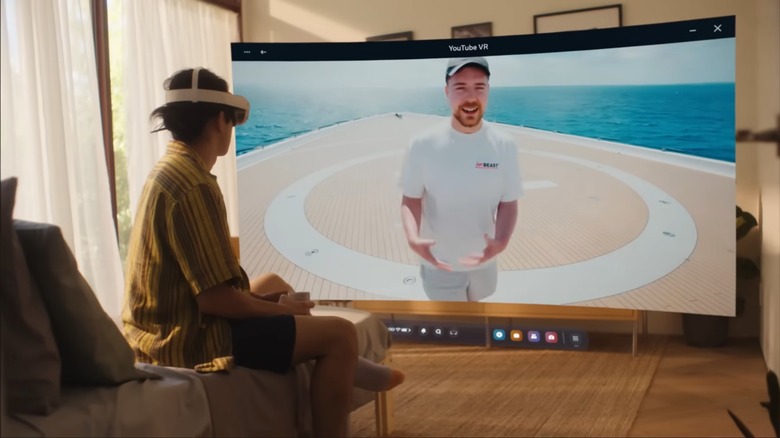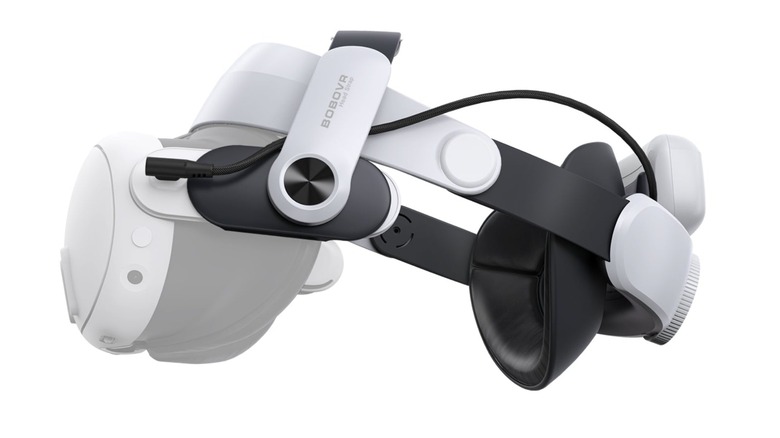7 Features That Will Help You Get The Most Out Of Your Meta Quest 3 VR Headset
The Meta Quest 3 is the latest and potentially greatest VR headset from Meta, if not any manufacturer. This recent release improves almost everything VR enthusiasts loved about Meta's previous Quest headsets and also fixes some of their flaws. Sure, battery life is worse than ever, but given all the new, more powerful technology under the hood, that issue could still count as an upgrade. Yet, for all of the improvements your average Meta Quest 3 user will encounter, even more enhancements are waiting off the beaten path.
Out of the box, the Meta Quest 3 provides a solid experience for most of its player base. The headset has plenty of games and exercise apps to keep users busy, but the vanilla settings might not be enough or even appropriate for all audiences. For example, some people might be more susceptible to motion sickness than the average gamer. Or perhaps they wear glasses. Or maybe someone is looking to save a few bucks on the Meta Quest store since the device costs as much as an Xbox Series X or PlayStation 5. Plenty of accessories could help new buyers in many ways, but the Meta Quest 3 also includes its fair share of features to improve and tweak the user experience.
Here are some built-in designs that can help you get the most out of the Meta Quest 3.
Controller's standard AA batteries allow easy swapping for continuous play
Rechargeable batteries are the future of gaming. Nintendo Switch and PlayStation controllers use built-in batteries. However, Microsoft still builds controllers that can take AAs and optional rechargeables — the Elite Wireless series notwithstanding. The Meta Quest 3's controllers can also run on either alkaline or lithium batteries, but while playing the Xbox Series X with a pair of AAs doesn't make much sense, playing VR games with them does.
When you set up the Meta Quest 3's free-floating controllers, you are provided several AA batteries, and for an extra $70, you can purchase a pair of rechargeable batteries built specifically for these peripherals. While that is a sizable price tag, especially given how much the Meta Quest 3 costs, it's a reasonable investment since you will save money in the long run by recharging your controllers instead of relying on disposable AA batteries. That doesn't mean, however, you should completely ignore the power of alkaline.
Unless you keep your controllers and their rechargeable batteries topped up, you might find them running out of juice before the Meta Quest 3 headset. When that happens, if you want to keep gaming, you need to pop and swap with some AAs. Due to the Meta Quest 3's aversion to wires, you can only charge controller batteries with a recharging base (sold separately). This design flaw prevents you from charging the battery while using it – not even Xbox controllers share this limitation. To charge Meta Quest 3 batteries while playing, you have to buy a second pair of controllers, place the rechargeable batteries in them, and rest them on the dock. So long as you have enough spare AAs in storage, you won't have to worry about running out of juice.
Headset's adjustment options can accommodate heads of multiple sizes
One size fits all. Many clothing manufacturers use that phrase to advertise that their products cater to customers of all shapes and sizes. That's all well and good for hats and pants, but what about eyes? The Meta Quest 3 not only solves this problem, but lets viewers see the changes in real-time.
Most, if not all VR headsets allow owners to adjust lens positions to match the distance between their pupils (interpupillary distance, or IPD for short). However, you usually have to take the device off first. The Meta Quest 3's lenses are controlled by an external scroll wheel. Gamers can spin the wheel while the headset is still strapped to their faces and see how much of a difference proper VR lens IPD can make. Alternatively, Meta Quest 3 owners can install a third-party smartphone app that measures their IPD and then use the Meta Quest 3 lens wheel.
While the IPD wheel accommodates eyes along the face's x-axis, what about the z-axis? What about people who wear glasses? Well, the Meta Quest 3 was designed with this demographic in mind, as the headset comes standard with pancake lenses. These glass sheets are thinner than most VR headset lenses, so users can play the Meta Quest 3 with their glasses on. If that still isn't enough, the peripheral also includes a depth adjustment button. Unlike the IPD wheel, you have to take the Meta Quest 3 off your head to access the button, which lets you slide the headstrap back and forth to accommodate glasses of different sizes. However, if you can't see without glasses and don't want to wear them inside a Meta Quest 3, plenty of third-party manufacturers offer prescription-strength lens replacements.
Wi-Fi and Bluetooth let users stream games from other platforms
The Meta Quest 3 and other Meta headsets have a leg up on rival VR systems because they don't have wires that can wrap around users' legs. The Meta Quest 3 is a standalone gaming gateway, so you don't need to own any other video game peripherals. Unless you want to expand your library beyond the standard Meta Quest scope, that is.
Due to the magic of Wi-Fi and Bluetooth, Meta Quest 3 owners can stream their PC, Xbox Series X, and even PlayStation 5 games on their devices. Say you want to play a VR game you bought through Steam on your Meta Quest 3. Simply install the game onto your PC via Steam, download Steam Link, wirelessly tether the headset to your PC, and you're good to go. The experience won't be as seamless as playing the game with a headset physically plugged into a PC, and if your computer doesn't have the hardware chops to run a VR game, you won't be able to stream it to your Meta Quest 3. Still, if you want to play "Half-Life Alyx" without getting tangled in headset wires, this is the way to go.
While you can't play Xbox or PlayStation 5 VR games on the Meta Quest 3 partially because Xbox doesn't have VR games, you can still stream titles you own to the headset via Xbox Game Pass and the PS Remote Play app. These programs simulate the experience of playing a game on a huge TV without needing one. You can also stream non-VR games to the Meta Quest 3 using third-party apps such as Immersed. These aren't as responsive as wired connections, but should become more wallet-friendly once developers work out all the kinks.
Use passthrough to view the real world without removing the headset
VR headsets and games are supposed to be as immersive as possible. You aren't separated from a digital world via a flat screen; you're essentially inside the world. For some people, this is peak gaming, at least until they need a drink or have to answer the phone. Then most headsets become a burden, but not the Meta Quest 3.
The Meta Quest 3 isn't just a VR headset; it's also an augmented reality (AR) device. The black bars on the Quest 3's face aren't just for show, they're RGB cameras that can record the real world and turn it into a live 3D video displayed on the VR headset's screens. These cameras are crucial for Meta's library of AR titles, and they can also scan a room and suggest the ideal play space, a new feature for the Meta Quest 3. These cameras are also the cornerstone of the Quest 3's Passthrough feature.
To activate Passthrough, quickly double-tap the left or right edge of the Meta Quest 3 headset. Doing so switches from whatever app you've got running to the Passthrough, not unlike the home screen of modern consoles. From there, you can use Passthrough for any number of activities. You can use them to spice up your living area with AR add-ons or invite friends over to your house without them having to physically show up in person. As previously stated, you can use Passthrough to take a break from VR gaming without prying your eyes away from the screen. Grab a drink or check your phone notifications; it's all possible with Passthrough.
Referral program allows users to save on purchases
Thanks to the ever-increasing prices of game consoles and services, and of games themselves, gaming is an expensive hobby. Any way you can save money while purchasing new games is welcome, especially when it's built into the gaming system.
Unlike other gaming consoles, the Meta Quest line of headsets includes a referral program that anyone can set up. Just send a referral link to a friend, and once they purchase and activate a Quest product, you receive $30 in store credit. This system isn't just limited to physical peripherals but also applies to games and other apps, so long as they cost at least $10. While you receive less money from these referrals (around $5 of store credit), the frugality goes both ways. Anyone who buys a Meta Quest game via a referral receives a 25% discount on their purchase.
Like other good digital game storefronts, Meta lets customers refund purchases if they don't like a game, app, or peripheral. If you think an item wasn't worth the money, you can return it within 30 days and receive a full refund (minus shipping fees). Of course, as with most refund policies, Meta Quest items and program returns are subject to certain caveats. For instance, if you bought a Meta Quest 3 from a store, you have to go through its refund policy/program, not Meta's. Furthermore, if you purchased a peripheral or program through the referral system, should you request a refund, the referral link's creator won't receive any store credit. Otherwise, what's to stop customers from abusing the two systems to receive free money?
Increase refresh rate beyond normal limits
The average gamer worries about framerates. The higher the frames per second, the smoother the image and the more responsive the game. VR gamers have a similar concern when it comes to refresh rates, as higher rates produce smoother games and are less likely to result in motion sickness. Even after you think you've cranked up the Meta Quest 3's refresh rate as high as you can, it can still go even further.
Out of the box, the Meta Quest 3 has three refresh rates: 72 Hz, 80 Hz, and 90 Hz. This might be enough for some gamers, but many people require even higher rates if they don't want their eyes to rebel against their equilibrium. The Meta Quest 3, much like the Quest 2, can go as high as 120 Hz, but only if you activate a hidden setting in the system menu, which only appears after you download the latest updates. Sometimes, however, not even official options cut it.
Talented programmers created the unofficial Quest Games Optimizer app for Meta Quest headsets, and as of October 19, the program supports Meta Quest 3. This third-party add-on, as its name suggests, helps optimize games beyond what the Quest's vanilla settings can muster. Graphics look crisper, but more importantly, performance is more smoothed out, reducing the probability of a user getting motion sickness. While this sounds great, there is a catch. Quest Games Optimizer costs $10 to install, and you have to run it every time you start up your Meta Quest 3 or other VR headsets.
That's a small price to pay to stave off nausea while playing your favorite games or while you're in the middle of a VR exercise routine.
Extend battery life with optional modes and external batteries
The more powerful a gaming platform, the bigger its energy drain, and VR headsets drain more than your average PlayStation 5 or Xbox Series X because they have so much to render and process. This isn't an issue for wired headsets since they're always plugged into a console or outlet, but the Meta Quest 3 runs on a battery. This device uses so much electricity powering virtual worlds that it's only good for three hours tops unless you dive into hidden options.
The Meta Quest 3's October 24 update added a new option to the power settings menu. Gamers can choose between favoring battery life at the cost of graphical fidelity or prioritizing smooth graphics instead of long play sessions. Think of it like the graphics options of modern Xbox and PlayStation games, but choosing higher graphics also improves framerates. The aforementioned Quest Games Optimizer can also hypothetically squeeze a bit of extra life out of a battery by optimizing games.
While built-in and unofficial tweaks aren't your only options if you want to scrimp and save on amperes, the more "effective" solutions won't do your wallet any favors. Meta and third-party manufacturers such as BOBOVR sell external battery packs. These items can almost double the Meta Quest 3's battery life. However, they not only need to be charged separately when emptied, but also add extra weight to the headset and require proprietary head straps. While external batteries are a potential godsend for people who want to play for hours at a time, the additional mass might be too much of a literal pain in the neck.







